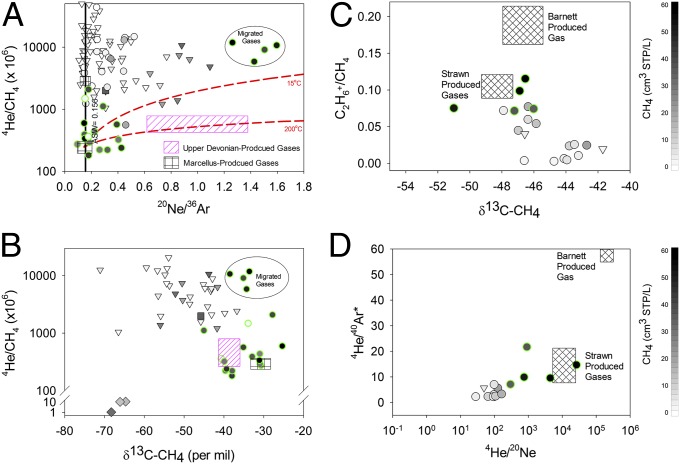Fig. 4.
4He/CH4 vs. 20Ne/36Ar (Upper Left) and 4He/CH4 vs. δ13C-CH4 (Lower Left) and C2H6+/CH4 vs. δ13C-CH4 (Upper Right) and 4He/40Ar* vs. 4He/20Ne (Lower Right) of produced gases and groundwater in the MSA (Left) and BSA (Right) at distances >1 km (triangles) and <1 km (circles) from drill sites. Normal trend groundwater samples in the MSA display 4He/CH4 and 20Ne/36Ar values that increase with [CH4] and that are significantly higher than Marcellus-produced gases. These data suggest natural geological migration of gas under relatively low Vgas/Vwater conditions (scenario 2). Samples <1 km from drill sites with evidence for fugitive gas migration (green-rimmed circles) plot along a trend between Marcellus (black box) and Upper Devonian-produced gases (pink hatched box) consistent with Scenarios 4 (annulus) or 5 (production casing) (B). A cluster of groundwaters near a gas well that experienced an underground blowout (circled in A and B) displays significant stripping and enrichments in both 4He/CH4 and 20Ne/36Ar, consistent with modeled solubility fractionation vectors (red dashed lines) for gas migration through the water-saturated crust (e.g., along faults or fractures) (scenario 6), but likely results from a well packer failure at depth (scenario 5). The Strawn- and Barnett-produced gases include data reported in ref. 8 and collected as part of the present study (Table S3). The molecular ratio of aliphatic hydrocarbons (C2H6+/CH4) (C) and noble gases (4He/40Ar* and 4He/20Ne) (D) in samples with evidence of fugitive gas contamination (green-rimmed circles) are significantly greater than other natural groundwaters in the area. The similarity between the C2H6+/CH4, 4He/40Ar*, and 4He/20Ne composition of the five impacted wells, including the two that changed between the first and second samplings (Fig. S6), and Strawn-produced gases, suggests an intermediate depth Strawn gas (scenario 4) as the most likely cause for the fugitive gas contamination observed in Texas.

